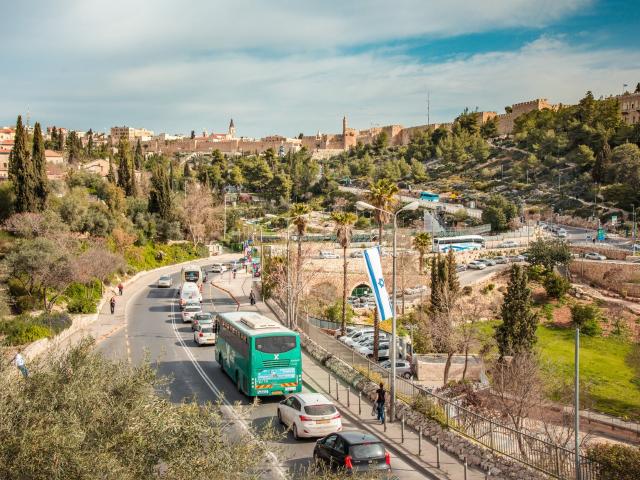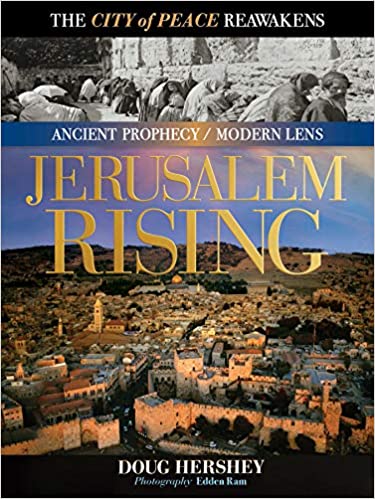New Book Jerusalem Rising Explores Amazing Transformation of Ageless City
In his first book, Israel Rising: Ancient Prophecy/Modern Lens, author Doug Hershey masterfully showed how God is restoring the land of Israel before our very eyes.
In his latest work, Jerusalem Rising: The City of Peace Reawakens, Hershey, along with photographer Edden Ram, take a historical and prophetic look at a city that is at the epicenter of prophecy from Scripture. Hershey and Ram draw from historic photos dating back to 1844 juxtaposed against those taken in the 21st Century to illustrate the amazing transformation of Jerusalem over the past 175 years.
I recently spoke with Hershey about why he draws inspiration from Old Testament prophet Zechariah in this new release and discuss some of the most striking changes in Jerusalem that have taken place since Israel became a nation in 1948.
This is your second book in this genre. What was the catalyst for writing Jerusalem Rising: The City of Peace Reawakens?
Well, during the photo shoot for Israel Rising, there's some really wonderful aerial photography that we got from a helicopter. This photo shoot was probably one of the coolest things I've ever done. We chartered a helicopter for three hours to recreate some of these aerial photos. And at one point, as we're flying over Jerusalem, I'm looking out the door and I'm literally looking at the Old City, the Temple Mount, the City of David, the Kidron Valley, the Mount of Olives … everything is so packed in there. It was a God's eye view and I just began thinking about how this city has been so significant throughout history and throughout the Scriptures.
I reference Ezekiel 5:5 in the book. It's about Jerusalem being the center of the nations. Here's this little city, and I decided I have to come back and do this somehow. At that time, I wasn't even sure how well “Israel Rising” was going to do, if anybody would even care at that point. But it really started there. Then, as the success of Israel Rising really began to grow I just thought, man, I've got to go back and feature Jerusalem.
This is the follow-up to Israel Rising. How does this book the same as the first book and how is it different? What distinguishes this book?
First of all, it's all part of a series called “Ancient Prophecy, Modern Lens”. There's no other people groups that has any type of ancient writings foretelling what's going to happen to the people in the land, their cities, its destruction, and desolation for thousands of years to then re-emerge as really a revival of not only the people in the land back to their history. Not the Romans, not the Greeks, not the Chinese, nobody has any type of ancient writings for this ancient prophecy, which is really just about the Jewish people. The Jewish people are the only people group in history that has any type of those ancient prophecies.
The idea is we're looking at an ancient prophecy from Old Testament prophets and looking at their restorations through then and now photography with a bunch of history all mixed in. So, they're similar in that way in that they are following the same format for the “Ancient Prophecy: Modern Lens” series. How they're different is instead of just focusing on an entire nation, I'm focusing just on the City of God. Furthermore, my thought was if I'm going to attempt doing Jerusalem, I have to go back to the beginning. And so, in that process, I was able to get ahold of some of the oldest photos of Jerusalem ever taken, dating back to 1844. As I got into working with those photos and realizing some of the things that were connected to those photos, we were able to really put some very unique things into the book. They were not just unique because I thought that they were cool. They're unique in history. Things that have never been done before. In “Jerusalem Rising” we did connect you to those photos.
Your latest offering draws inspiration from the book of Zechariah while the first one was inspired by Ezekiel. How does this one document the fulfillment of Zechariah’s prophecies?
Zechariah 8 begins with God saying, “I'm going to return to the city and dwell with my people. I'm going to bring all of the people back from the East, the West, the North and the South. I'm going to bring them back to Jerusalem. Old men and old women will sit in the streets for safety. The children will play in the streets and that the nations will begin flooding back to Jerusalem.” Here in our day, we've really begun to see a culmination of a lot of that process. I say it’s a culmination but it’s just beginning. This process is really just beginning, and the people really are coming from the four corners of the earth back to Jerusalem. For the first time in 1,900 years, Jerusalem in the last 50 years, has been enjoying a relative calm and peace in a way that hasn't happened in centuries.
It is old men, old women and children. Those things aren't just about old men, old women, and children being in the streets, but it speaks to that they are there in safety and there's some peace there. Prior to COVID, in 2018 and 2019, these were the largest tourism numbers in Israel ever. Four million people in 2018, 4.5 million in 2019 prior to COVID. Never before have the nations flooded to Jerusalem like they did in 2018 and 2019. In Zechariah 8, clearly, it's in the context of the nations, coming to worship the king in Jerusalem, but it's undeniable that we are seeing the very beginning of fulfillments of those things. In history, never has there been the nations of earth coming to Jerusalem the way that they had in 2018 and 2019.
This is the very beginning processes of these things that Zechariah talks about, because these are things that historically have really never happened before. They're not only happening right now. We're able to document them through not only just photography in general, but to be able to compare them through then and now photography, compared to what it was 50 or 100 years ago. In the case of these old photos from 1844, that's 175 years to be able to compare the difference between the city. That's not just shocking to look at, that’s historical.
There have been tremendous changes to the landscape in and around Jerusalem over the last 70 years or so. What do you find to be some of the most striking changes that have taken place since Israel first became a nation in 1948?
I would think one of the most dramatic changes is the people. When Jewish people come back from all over the world, and putting Bible prophecy aside, there's no other people group that has been scattered throughout the world for thousands of years to return to the exact same piece of real estate, as an identifiable recognizable people, speaking the same language, has the same customs, the same Scriptures. That in itself is a historical anomaly. So, when God is bringing His people back to the land to fulfill His promise to Abraham, Isaac, and Jacob, they're coming back with the things that they've learned from the nations, which includes building, which includes farming, medical, and science advancement in technologies. So, while we can talk about the revival of the land, restoration of the deserts, and desert farming, and the massive amount of buildings that can be seen then and now, all of that really begins with people.
That's really what God cares about. His heart is towards His people. And when people that He's returning back to the land are coming back with all of these things they've learned from the nations, but still very distinctly Jewish, it becomes just this beautiful sort of a mixing pot. To me, that's part of the real treasure of Israel. There's so much advancement and so much creativity coming out of the land. Some certainly by necessity and others by just sheer innovation. For example, needing to make the deserts bloom, and they're finding a way to do it. The return of the people and just the things that they've been able to do have been really some of the most stunning.
If you had to pick one area of Jerusalem that you feel is the most vivid and truly represents what Israel truly is, where would that be?
I would say it is in the Old City and around the Western Wall, Temple Mount area; it is the place of the First Temple. It's the place of the Second Temple. It's an area of that's built over the mountains of Mariah according to the Scriptures. Why that's special to me is that the very first time the word love is used in the Bible is in Genesis 22:2. And it's in the context of God telling Abraham, “Take your only son whom you love and sacrifice him on the mountains of Mariah.” So, isn't it interesting that later on that God so loved the world that He gave His only son for sacrifice? And where did He die? He dies in Jerusalem, near Mount Moriah. So, you have this concept of an alpha father willingly giving his only son for sacrifice.
That's the context of the first time the word love is used. During the time of David and Solomon, the first temple was built at Mount Berea. That's where the second temple was built. That's where Jesus would come and do a lot of teaching. He dies not far from there and is resurrected not far from there. Everything is really tight together. To me, that's just such a special place.
Prior to COVID, I'd been spending about six months a year in Israel leading groups and putting some of the research for this book together. And sometimes people ask me, does it ever get old or does it ever just become sort of normal? The answer is no. Every time, it stirs my heart in a way that I hope it never gets old. I hope it never becomes normal. That’s because it's just a special place, it's special to me, but it's also special because when you read the Scriptures, this is the place where glory filled the temple. It's where all of these amazing things happen as far as God's desire to interact with man.
After people have read and viewed Jerusalem Rising what would you like readers to take away from the experience? What is your greatest hope for the book?
The overall theme of the book is that God is keeping His promises. Here are things that are promised in the Scriptures 2,600 years ago that are coming to pass in a very literal, tangible, tactile sort of way. It’s not even so much about Israel or the Jewish people, or even Jerusalem, as it is about God fulfilling His Word. God is faithful. God is able to keep His promises. And if God is able to keep His promises to Israel and the Jewish people over thousands of years, then He is more than able to keep His promises to you and I today.
We're seeing some of these promises unfold right now. To me, that’s the whole overall thing. This isn't even so much a photo book, but to be able to document the faithfulness of God and not just in an allegorical or symbolic way. This book is all about here's the prophecy, nothing like this has ever happened before, and here are some photos that are stunning in the light of what God promised. This is because He is doing exactly what He said He would do. The Bible means exactly what He says. It's very clear He's doing exactly what He said. It's all about God fulfilling His promises and demonstrating His faithfulness to the earth. And He's doing that through Israel.
Watch a Trailer for Douglas Hershey's Jerusalem Rising: The City of Peace Reawakens:







